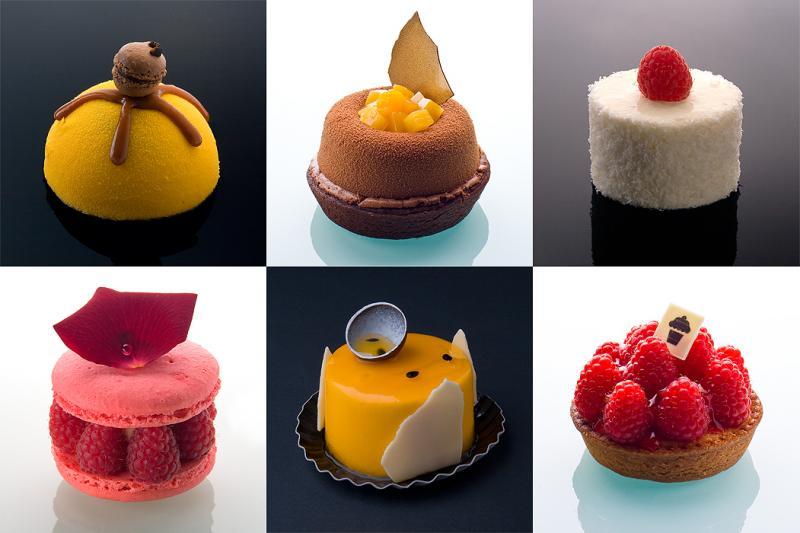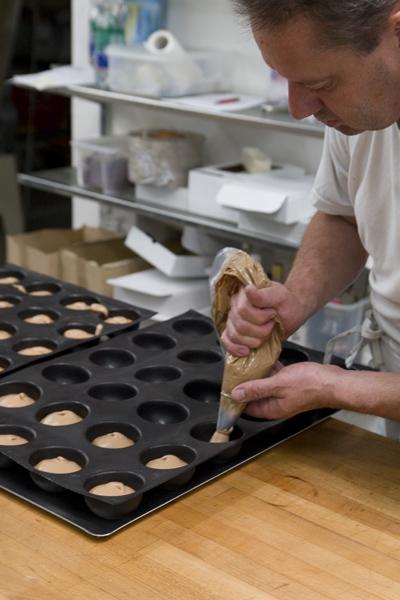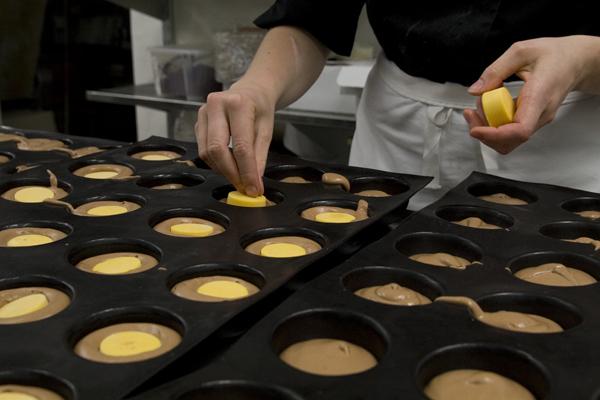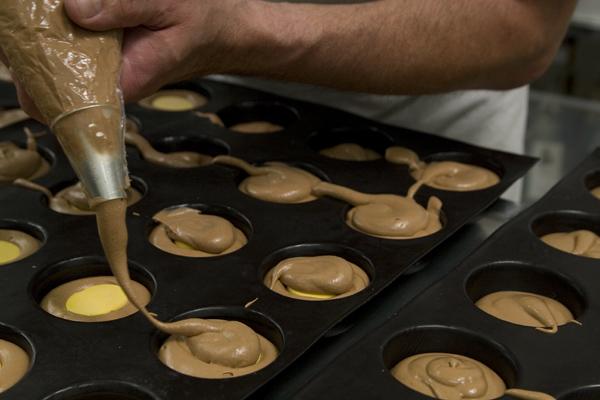
lironp
-
Posts
142 -
Joined
-
Last visited
Content Type
Profiles
Forums
Store
Help Articles
Posts posted by lironp
-
-
hi,
doing this kind of mousse cake (in france they are called petit gateau) is our main business, we produce about 2000 per week. luckily its not as complicated as richard wrote. you certainly need moulds, which you can get from demarle. first you prepare your mousse, if you got a lot of pieces to do at once you´ll want to keep your mousse slightly more fluid to keep it from setting on you while filling. next you fill some mousse into the molds, and add your core, which is usually a jellied coulis, a brulee, a bavaroise, or simply a compote forzen in small cylinders. you add the core by pressing it into your mousse, now you add more mousse and finish with a piece of biscuit, dacquoise, brownie or whatever you like, scrape it clean and put it in the freezer for 24h. its true that you gain a bit of quality if you use a blast chiller (we have one) but you can do fine without. here is a nice recipe for a nappage neutre, once cooked you can store it in the fridge and flavour it with any fruit puree (20%). you glaze by pulling your petit gateau from the freezer, put them on a grate and laddle the 50C nappage on. the nappage will set pretty much instantly, now you pull em from the grate with an offset spatula and put em back in the freezer until you need them....
Wow! These look amazing! The passion fruit one is my favourite, too bad I can't understand a word in your website

-
The white foam happened to me a few times as well, I think I incorporated too much air when whisking at the beginning. I switched to using a spatula instead (which involved an interesting experiment of me finding out the hard way which of my spatulas was made out of silicone, and which out of plastic
 ) and one thing I did notice is that when I heated it enough and the mixture thickened, the white foam did get incorporated eventually
) and one thing I did notice is that when I heated it enough and the mixture thickened, the white foam did get incorporated eventually -
How hot was the white chocolate? It might have taken the dark chocolate out of temper...
-
The citron shaped ones are adorable. One of the flavours I made was Pierre Herme's lemon cream- the recipe is running over the internet, with some white chocolate for stabilization, in a dark chocolate shell. His lemon cream is amazing, I can eat it endlessly
-
Well, it sounds like I have no choice

-
Do you think there is any added value to buying this book after buying the original Chocolates and Confections?
Having purchased quite a few books by now, I would heartily endorse the first Greweling book. It's the only book I've got which covers so MANY topics so thoroughly. If you're not going to be making products for sale, you'll have to scale down the formulas, but it's a wonderful book.
I must confess, I have an addiction- I love buying cookbooks, pastry books, chocolate books. I've bought most of the books that have chocolate in their title, and I'm trying (pretty unsuccessfully in the meantime
 ) to cut back. I have his first book, and absolutely love it, and though my first instinct was to buy anything with his name on it, I was wondering if it has any added value over the first one or if it just sort of simplifies the first one...
) to cut back. I have his first book, and absolutely love it, and though my first instinct was to buy anything with his name on it, I was wondering if it has any added value over the first one or if it just sort of simplifies the first one... -
They look gorgeous!
-
Do you think there is any added value to buying this book after buying the original Chocolates and Confections?
-
Looks yummy!
-
I use glenfidich with milk chocolate- I think it is the chocolate that compliments it the best. I don't even like whiskey, but I do like this ganache. I use molded shells with dark chocolate:
80g cream
250g milk chocolate
30g whiskey
30g butter
-
That baby freaked me out!

Very interesting, I wish I could have a taste of all of those chocolates!
-
Hi Ilana, thanks! And thanks for the recommendation!

I had no idea caramel was so hydroscopic, I guess I'll give up on this idea for now...
-
Thank You!

The area I'm in isn't humid at all right now, is it supposed to happen so fast (a few hours)?
If I add glucose to the caramel can it impact this in any way? Or butter? Is there anything else I can add to prevent this? How about making butter crunch and then breaking it- Will the same thing happen? I've caramelized nuts the same way- stirred sugar with nuts until the sugar liquefies, added some butter and poured out on a sheet till it hardens. In this case nothing happened to the coating. Is the difference the temperature the sugar was cooked to? Or the presence of the nuts? Or just plain voodoo?
Sorry for all the questions, it's just driving me nuts- my whole batch of chocolates currently has orange smudges on top- not very attractive...
What I'm trying to do is create a creme brulee chocolate- make creme anglaise (based mostly on butter, not cream), add to white chocolate, add caramel pieces, dip in dark chocolate and decorate with caramel pieces. Is there any candy I can make that will stay crunchy while exposed to air?
-
This is my first post in this forum (Thanks Ilana for recommending it!), over the past few moths I've been reading all 132(!) pages (mostly chocolate & confections related) and I've learned a lot! I've been making chocolates for about 2 years, I've bought every book that came my way, and experiment with new stuff every weekend.
The first question I'd like to ask is: This weekend I tried making caramel for decorating some chocolates- my intention was to make the caramel, spread it out thinly on parchment paper, then break it up into crumbs, put some in my filling, and sprinkle some on each dipped chocolate.
I tried 2 ways- first I caramelized 75 grams of sugar with 25 grams of butter, then I caramelized just 100 grams of sugar. In both cases, after the caramel hardened (which took a few minutes), it started what looked like sweating, until it turned to be completely liquid within a few hours. Is this what normally happens or am I missing something? Is there any way to make these hard pieces of caramel and keep them that way?





Ganache: Tips, Techniques & Troubleshooting
in Pastry & Baking
Posted
Try heating it gently again and then adding small quantities of hot milk, while mixing from the center and out, until it emulsifies